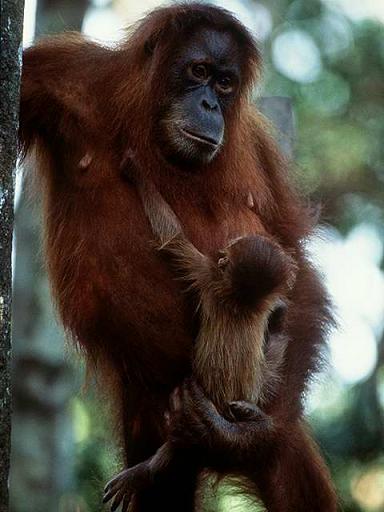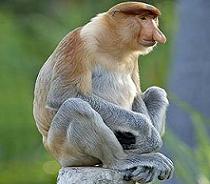
 |
|
|
|---|
| Kalimantan is 73% of the island of Borneo, which is the third largest island in the World. It is a relatively flat island dominated by large meandering river systems in which the water may be tidal up to 150 km inland. Most landscapes have been modified by the activities of the indigenous people who have been in Kalimantan for at least 35,000 years (Majid 1982). Borneo (including Kalimantan) supports the largest expanse of tropical rainforest in the Indomalayan realm. It is the main center for the distribution of genera of Malesian flora and Indomalayan fauna. Forest types include Mangrove Forests, Peat Swamp Forest, freshwater non-peaty swamp forest, the most extensive Heath Forests (kerangas) in the Realm, lowland Dipterocarp forest, forests on limestone and a variety of Montane Forest formations (MacKinnon et al. 1986). |

|
|---|
Tropical forest species tend to be somewhat fragile assemblages where many species of trees, mammals, birds and even invertebrates occur at low densities and are often restricted to a specific forest type (MacKinnon et al. 1986).
Consequently, these forest species are especially susceptible to extinctions. This is a reflection of the observation that species richness of tropical forest species is often linked to species rareness (Elton 1975; Whitmore 1984). Massive and expansive threats are dramatically reducing biodiversity in Kalimantan. These threats usually involve the interplay between serial uncontrolled wildfires during the 1980s and 1990s, land conversion for agricultural purposes and unrestrained logging practices, both legal and illegal, that have deforested Kalimantan at Amazonian rates (e.g., The World Bank (2001) predicts that Lowland Rainforests of Sumatra and Kalimantan will be exhausted as a source of commercial timber by 2005 and 2010, respectively). The habitats most threatened by these developments are the more accessible lowland forests, where species richness is greatest (MacKinnon 1990).
For vertebrate groups, Borneo has a similar number of species to the smaller island of Sumatra (see Table 3.3) For example it has 222 mammals compared with 196 on Sumatra and its offshore islands and 183 on Java. The leopard, Panthera pardus (found on Sumatra), and the Wild Dog, Cuon alpinus (found on Java), are not found in Borneo, but it has more endemic land mammal species than Sumatra (44 versus 23, MacKinnon et al. 1986).
Borneo has 13 species of primates and 10 species of tree shrews, which is more than any other Asian mainland or island of similar area. Charismatic mammals in Kalimantan include the Asian Elephant (Elephas maximus), Banteng (Bos javanicus), Orangutan (Pongo pygmaeus), Proboscis Monkey (Nasalis larvatus), Bornean Gibbon (Hylobates muellerii), Flat-headed Cat (Prionaluris planiceps), Clouded Leopard (Neofelis nebulosa) and the Sun Bear (Helarctos melayanus).

A great deal of public concern has recently been focused on the impact of the destruction of the Kalimantan (and Sumatran) Lowland Rainforests on the survival of the Orangutan. Recent discoveries of substantial new populations of orangutan in Central, West and East Kalimantan, including in secondary forests, have led to an estimation doubling the population to 50,000-60,000 individuals for the combined population size in Kalimantan and Sumatra. However, given the rate of degradation of their preferred Lowland Rainforest habitats, it is still predicted that there will be no wild orangutans surviving in 20 years time (Jakarta Post 2/3/2004).

Borneo has 420 species of resident birds compared to 465 on Sumatra and 340 on Java and 240 on Sulawesi. Thirty-seven of these are endemic to Borneo. Some 28 Bornean bird species, including 4 endemic genera (Haematortyx, Chlamydochaera, Chlorocharis and Oculocincta), are restricted to the Bornean mountains – many of these are restricted to montane habitats. They include the Storm’s Stork (Ciconia stormi), the Blackshouldered Ibis (Pseudibis davisoni), Galliformes pheasants and the Straw Headed Bulbul (Pycnonotus zelanicus).
MacKinnon et al. (1986) consider that Borneo is also probably one of the richest islands of the Sunda Shelf for fishes, amphibians, reptiles and invertebrates. It has at least 166 species of snakes, compared with 136 species on the Malay Peninsula, 150 species on Sumatra and 64 species on Sulawesi. It is also much richer in amphibians than the other Sundaic islands, with at least 100 species, (36 for Java, 29 for Sulawesi). A total of 394 species of freshwater fish are known from Borneo and 149 of these are endemic. This compares with 272 species (30 endemic) for Sumatra, 132 for Java and 68 species for Sulawesi (Kottelat et al. 1993).
Invertebrate groups are generally poorly known for Kalimantan. Swallowtail butterflies, with four endemic species, are one of the few well-known groups (MacKinnon et al. 1986). The many threats to the fauna of Kalimantan have already caused several species to be listed as endangered and placed on the IUCN red list of threatened animals. These include the Malay Peacock Pheasant (Polyplectron m. schleiermacheri), Clouded Leopard, Bay Cat, Marbled Cat, Flat Headed Cat, Orangutan, Proboscis Monkey and Western Tarsier (Tarsius bancanus), Elephant and Banteng (Bos javanicus). In the last several decades, the Sumatran Rhinoceros has disappeared from Tanjung Puting and Kutai National Parks and may be extinct on Borneo (MacKinnon et al. 1986). MacKinnon and Phillips (1993) and MacKinnon et al. (1986) list another 23 birds that are endangered.
Overexploitation of the crocodile (Crocodylus porosus), the False Gavial (Tomistoma schlegeli) and marine and river turtles has also caused these species to be endangered. Three of the swallowtail butterflies are also endangered.
These are Pailio acheron, Graphium procles and Triodes andromache. Many of the above species that have become endangered are mobile predators, such as all species in the cat family, or are species that are large (Rhinoceros, Elephant, Orangutan, Banteng) and require large home ranges to obtain their living resources. Or if small, such as some of the birds and bats, they obtain there living resources from widespread areas. To survive in the long-term, such species require areas that exceed the boundaries of any single gazetted protected area (MacKinnon et al. 1986). |
|---|
Source : Report on Biodiversity and Tropical Forests in Indonesia, USAID/Indonesia, 2004. Prepared by : (1) Steve Rhee, M.E.Sc. (2) Darrell Kitchener, Ph.D. (3) Tim Brown, Ph.D. (4) Reed Merrill, M.Sc. (5) Russ Dilts, Ph.D. (6) Stacey Tighe, Ph.D.
|
 |
 |
|---|
|
||||||||||||
|---|---|---|---|---|---|---|---|---|---|---|---|---|
|
|
||||||||||||